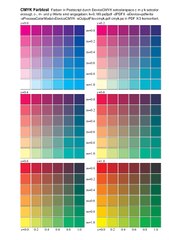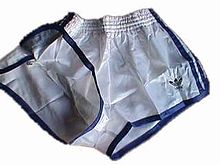Masking (reproduction technique)
Masking is a term used in reproduction technology and describes photomechanical color correction . Masking is necessary because the color filters used in the reproduction camera cannot precisely separate the color space and the printing colors do not correspond to the ideal basic colors . In addition, masks are used to change the gradation, for example light masks to improve the drawing in the light areas of the image and depth masks to reinforce the drawing in the shadow areas. There are also cutout masks that limit an image in a figurative or rectangular manner.
Basics
The human eye mixes all color impressions from the three basic colors cyan , magenta and yellow , which are also known as subtractive color mixing . If you mix two of these basic colors, you get the mixed colors green (yellow + cyan), blue (cyan + magenta) and red (magenta + yellow). All three basic colors together result in black.
That is why the CMYK color model was developed, which forms the technical basis for modern four-color printing . The abbreviation CMYK stands for cyan, magenta, yellow (yellow) and black (key) as color depth. Each colored template must be broken down into these four colors so that they are reproduced as faithfully as possible when printed on top of one another. Black as the fourth color gives the picture a better sense of depth and is therefore often referred to as depth .
The decomposition of the original in the three primary colors occurs when recording in the camera with the aid of color filters in the respective complementary color , which is red in cyan, green for magenta and blue with yellow. Since a basic color and its complementary color theoretically result in black, for example with a green filter the red parts of the original will appear black and no light falls on the film in the camera's beam path; the result is a negative of the magenta color separation. At this point, the masking starts in order to eliminate deficiencies in gradation and color separation as far as possible using purely photographic means.
Masking with compensatives
This method is particularly suitable for colored reflective originals. First, four color separations (CMYK) are produced in the manner described above. One positive from each of the negatives is exposed on film in the contact device, which corresponds to the negative in terms of blackening and gradation. Negatives and positives are assembled layer by layer:
| Color separation / negative | combined with positive | results in mask for | Color separation / negative | yields a revised positive for |
|---|---|---|---|---|
| Cyan | magenta | magenta | Mask + magenta | magenta |
| magenta | yellow | yellow | Mask + yellow | yellow |
| yellow | Cyan | Cyan | Mask + cyan | Cyan |
The actual masks are therefore made from the combination of negative + positive. They are neither negative nor positive, rather only contain the difference image between the negative and positive color separations, which is used to compensate for the defects in the color separation . It is important that the intermediate positives in the tonal values are exactly the opposite of those of the negative from which the mask is to be drawn. Now the actual mask can be created with the effect that enhances the natural colors. The entire masking process using compensators can now be simulated very easily in ADOBE PhotoShop.
Silver masks
The method is suitable for reflective originals and transparencies . The correction is made by three different masks, which are produced on a slightly blurred mask film. In contrast to dye masks, they are monochrome gray / white and are therefore referred to as silver masks. The masks are made behind different filters, namely with a bright orange filter for Cyanmaske , with a green filter for the magenta mask and a blue filter for the yellow mask . In the case of slides, the mask, which at the same time reduces the density range, is mounted on the back of the slide before the color separations are produced. In the case of reflective originals, the masks are placed on the suction wall of the camera above the unexposed film.
Color masks
The best-known masking methods using color masks are Multimask from Agfa-Gevaert and Trimask from Kodak . The three necessary correction masks have been combined in a single film. The mask film consists of three colored mask layers superimposed on one another. The cyan-colored layer works when the red filter is used , the magenta-colored layer with exposure of the green filter , while the yellow layer is intended for the blue filter . However, there are fluctuations in the development of these color masks. When it turns out that the silver masks can be developed in any lith developing machine, it is the end of the color masks.
Light and depth masks
Light masks counteract the flattening of the bright parts of the image, which often occurs in photographic reproduction. A light mask is combined with a negative and only shows highlights and light tones, but is crystal clear in the other areas. The shot is taken through a tight exposure on hard-working photographic material. Together with the negative, the combination results in a significantly improved highlight drawing.
Depth masks are combined with a positive and are intended to remove the flattening of the depth drawing. The mask is briefly exposed on hard photo material so that only the outermost depths can be seen. The positives to be masked must be sufficiently open in the depths that the shadow mask can take effect.
Cutout masks
A distinction must be made between figurative and rectangular cutouts . Figural cutouts can either be cut from masking , red or ulano foil with a scalpel or drawn manually on a blank film. In favorable cases, a photographically generated cutout mask can also be used, which only requires some manual rework. The actual release takes place by post-exposure of the negative or positive to be released with the help of the mask and a register or register bar. Rectangular cutouts are cut from masking film with a ruler and scalpel and used for post-exposure with the help of the fitting strip.
literature
- Helmut Kipphan (Hrsg.): Handbuch der Printmedien. Verlag Springer, 2000, ISBN 3-540-66941-8
Individual evidence
- ↑ Basics of light, color, filters ( page no longer available , search in web archives ) Info: The link was automatically marked as defective. Please check the link according to the instructions and then remove this notice.
- ↑ Helmut Kipphan (Hrsg.): Handbook of Print Media: Technologies and Production Processes . Springer-Verlag, Berlin 2000, ISBN 3-540-66941-8 , p. 519
- ↑ Hans K. Kerner et al. a .: Lexicon of repro technology . Vermittler Verlag, Mannheim 2007, ISBN 3-86656-536-4 , p. 417




